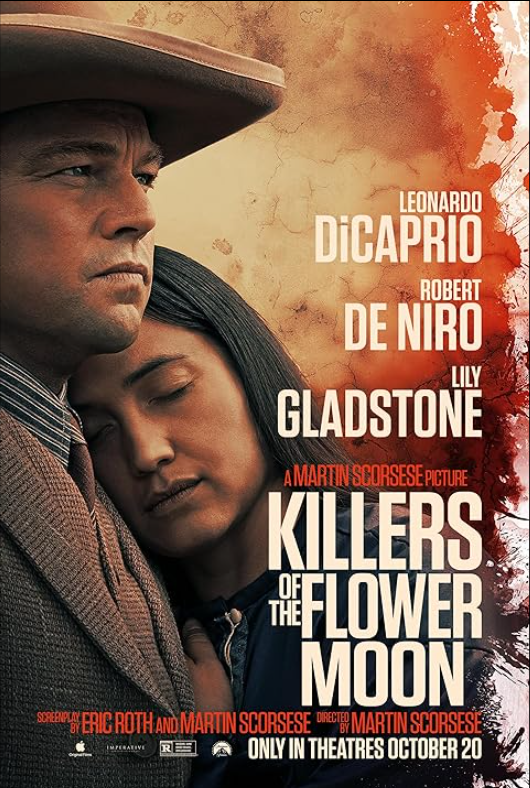As a riveting score swells and “Killers of the Flower Moon” begins, the Osage tribe of Oklahoma rejoice in the newly discovered oil that will bring them great success, but so much tragedy. Martin Scorsese’s latest feature masterfully and boldly recounts the horrors endured by a Native American community in the 1920s.
“Killers of the Flower Moon” is an adaptation of David Grann’s novel of a similar name. After an oil boom, Osage headrights — land grants worth millions of dollars — became a hot ticket item among white transplants. The film depicts white men who married Native women to acquire the headrights and line their pockets. However, when the line of succession was not in their favor, these men killed the family members standing between them and the fortunes.
Lily Gladstone plays Mollie Kyle, an Osage woman wealthy from oil money, while Leonardo DiCaprio portrays her white husband, Ernest Burkhart. Mysterious murders begin to plague the Kyle family and the tribe around them, and as a conspiracy unravels, the white members of the community scramble to conceal the greedy and murderous behavior that left 60 Osage dead by 1930. The film also features Robert DeNiro as William Hale, Burkhart’s mastermind uncle, and Jesse Plemons as Tom White, the FBI agent sent to Oklahoma to uncover it all.
The entire ensemble offers breathtaking performances. DiCaprio, DeNiro and Plemons all demonstrate why they have been nominated for Oscars, but it’s Gladstone who stands out. As a relative newcomer to Hollywood, she showcases an astounding ability to steal the show from her far more famous costars.
Grann’s novel, “Killers of the Flower Moon: The Osage Murders and the Birth of the FBI,” as the title suggests, spends more time following the resulting FBI investigation. In a choice that some might question at first, Scorsese’s decision to highlight the atrocities from the perspective of the victims was an important one. Because the film follows the killings as they occurred — instead of taking the retrospective view the novel had — each murder, although brief, packs an emotional punch that sticks with the audience. As the death toll rises, the depiction of white violence remains unflinching, pulling the viewer further into the film.
Scorsese’s directorial prowess shines through in each of these scenes. His experience bolsters his ability to conquer this sprawling story, while still giving the audience time to understand each central character. The beautiful cinematography amplifies this humanity. The camera’s massive wide shots and intimate close-ups sprinkled throughout the film introduce emotional weight. In addition to a magnificent score by Robbie Robertson and the gripping dialogue written by Scorsese and Eric Roth, every cinematic aspect of the film is spectacular.
Scorsese is no stranger to an adaptation, but concerns about misrepresenting gangsters seem trivial when compared to the gravity of this film. Earlier this year, Christopher Nolan’s “Oppenheimer” faced backlash due to its lack of representation of the Japanese victims of the titular character’s creation. Hence, audiences, and especially Osage people, were incredibly skeptical of how a white man would direct this story. Initially planning on following the FBI agents, Scorsese decided to shift focus to the Osage after meetings with the tribe that continued throughout production.
The dialogues from those meetings are present throughout the story. Although mainly focusing on Burkhart, a facet of the movie that Osage people are conflicted about, the film is initially rich with Native American culture. Scorsese adeptly navigates the source material while adding the tribal rituals, songs and dances of the people that our main character affects.
Native American culture is laced into the beginning, but as the film gains momentum near the halfway mark, the lack of cultural displays becomes glaringly obvious. Soon, the film became the “movie all about the white guys” Scorsese told TIME magazine he was not going to write. By the end, the film offers far too much sympathy toward a man who killed his wife’s family to reap her inheritance.
Despite questionable focal points, the epic does tell the full story, sparing few details. However, more details equals a longer runtime — I don’t use the term “epic” lightly here. Clocking in at a whopping 3 1/2 hours, it’s one of the longest movies released in theaters this year. While some may describe the runtime as a fault of the film, every minute is engaging and wholly necessary, especially when dealing with such a delicate subject matter.
However, this has not stopped a few theaters around the world from creating their own intermissions that neither Scorsese nor his editor, Thelma Schoonmaker, approved. While, yes, sitting in the theater for four hours seems like a shift at work, every minute pays off by the end.
“Killers of the Flower Moon” may have its faults, but it presents the full story while shedding light on a dark chapter in American history. It’s a film that demands all of your senses, as all great filmmaking does. At 80 years old, Scorsese shows no signs of slowing down as a director, and this film emphasizes why many consider him one of the greatest filmmakers to ever pick up a camera.



